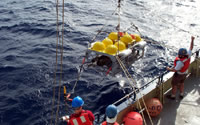
An ocean bottom seismometer (OBS) is deployed for earthquake studies. (Photo by John Whitehead)
Hundreds of earthquakes occur every day around the world, most of them underneath the oceans, while the vast majority of instruments used to record earthquakes are on land. As a result, advances in understanding basic earthquake processes have been limited by the available data. Scientists are improving this situation by developing an instrument that records both small and large earthquakes on the seafloor.
Jeff McGuire and John Collins at the Woods Hole Oceanographic Institution (WHOI) plan to deploy 40 ocean bottom seismometers, or OBSs, on the ocean floor along the East Pacific Rise in the Eastern Pacific Ocean. Their target area is a section of ocean about the size of the states of Connecticut and Rhode Island combined.
The instruments will use a pair of seismometers, one known as a broadband seismometer, the other as a strong-motion accelerometer, to record the ground movements from undersea earthquakes, just like seismic arrays on land. They will be placed on the Quebrada/Discovery/Gofar (QDG) transform fault system for one year starting in early 2007. This area is known to have large earthquakes, greater than magnitude 5, preceded by foreshocks, or small shocks around magnitude 3, in the last hour before a large rupture occurs. Current ocean bottom seismometers record moderate ground motions from nearby small earthquakes and can register the foreshocks, but do not have the range to record the main shocks, McGuire said.
McGuire and Collins have received a $1 million grant from The W. M. Keck Foundation to develop a new suite of OBSs capable of accurately recording both foreshocks and mainshocks. Ten will be built, to be used in conjunction with current instruments from the U.S. national Ocean Bottom Seismograph Instrument Pool or OBSIP, which supplies OBSs to researchers around the country for their research projects. WHOI and the Scripps Institution of Oceanography maintain and operate the pool.
"This grant from the Keck Foundation has enabled us to take a major step forward," McGuire said. "Together with existing pool instruments and ship time, both supported by the National Science Foundation, we will be able to record large undersea earthquakes directly on top of the faults that generate them. Although our test area is in the middle of the Pacific Ocean, this technology will have broad application to other faults zones, including those of significant societal relevance such as the nearshore subduction zone off Oregon and Washington."
Advances in electronics in the past five years or so, including electronics that require less battery power, have made a new generation of OBSs possible. While some parts of the new OBSs will be bought from commercial firms, other aspects of the instruments will be designed and built by WHOI scientists and engineers. The new generation OBS will be tested this summer and fall and prepared for deployment on the East Pacific Rise in water depths of 3,500 to 4,000 meters (about 11,500 to 14,000 feet).
